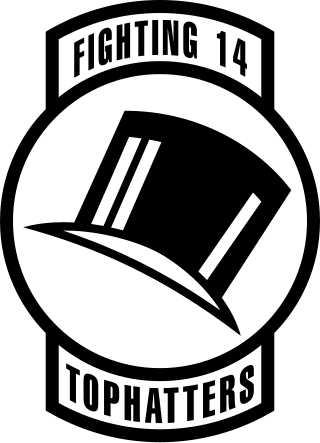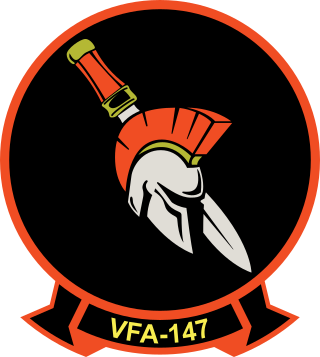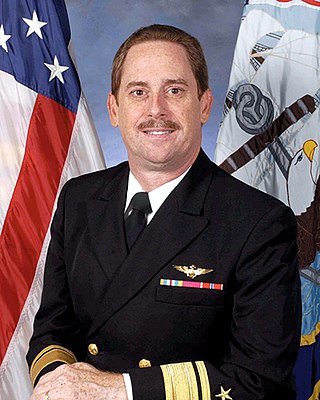
The Strike Fighter Squadron 14 (VFA-14) "Tophatters" are a United States Navy fighter attack squadron based at Naval Air Station Lemoore. They fly the F/A-18E Super Hornet, and are the Navy's oldest active squadron, having formed in 1919. Their callsign is Camelot, and their tail code is NG.

Naval Air Station Lemoore or NAS Lemoore is a United States Navy base, located in Kings County and Fresno County, California, United States. Lemoore Station, a census-designated place, is located inside the base's borders.

Naval Air Station (NAS) Oceana or NAS Oceana is a United States Navy Naval Air Station located in Virginia Beach, Virginia.

Strike Fighter Squadron 147 (VFA-147), also known as the "Argonauts," is a United States Navy strike fighter squadron based at Naval Air Station Lemoore, California (USA). VFA-147 was established on 1 February 1967 and flies the F-35C Lightning II, becoming the first non-training F-35 squadron in the U.S. Navy.

Strike Fighter Squadron 101 (VFA-101), also known as the "Grim Reapers", was a United States Navy Fleet Replacement Squadron (FRS) based at Eglin AFB, Florida. After the West Coast FRS for the F-14 Tomcat, VF-124, was disestablished in the mid-1990s, VF-101 became the sole F-14 FRS. At the time it was based at NAS Oceana in Virginia. With the retirement of the F-14, VF-101 was deactivated in 2005. It was reactivated in 2012 and redesignated Strike Fighter Squadron 101 (VFA-101). It was one of two F-35C Lightning II FRS before being deactivated in 2019. It was based at Eglin AFB, Florida with the joint 33d Fighter Wing, as a subordinate unit of the U.S. Navy's Strike Fighter Wing, U.S. Pacific Fleet.

Strike Fighter Squadron 146 (VFA-146) also known as the "Blue Diamonds" is a United States Navy operational fleet strike fighter squadron based at Naval Air Station Lemoore California. They fly the F/A-18E Super Hornet and are attached to Carrier Air Wing 17, deployed aboard USS Nimitz. Their tailcode is NA and their radio callsign is Diamond.

Strike Fighter Squadron 137 (VFA-137), also known as the "Kestrels", are a United States Navy F/A-18E Super Hornet strike fighter squadron stationed at Naval Air Station Lemoore, California. Their radio callsign is "Falcon".

Strike Fighter Squadron 113 (VFA-113), also known as the "Stingers," is a United States Navy strike fighter squadron based at Naval Air Station Lemoore, California. They are an operational fleet F/A-18E Super Hornet squadron attached to Carrier Air Wing 2 (CVW-2) and based at NAS Lemoore, California. Their tailcode is NE and their radio callsign is Sting.

Strike Fighter Squadron 125 (VFA-125), also known as the "Rough Raiders", is a United States Navy strike fighter squadron based at Naval Air Station Lemoore, California. The "Rough Raiders" are a Fleet Replacement Squadron flying the F-35C Lightning II.

Strike Fighter Squadron 192 (VFA-192), also known as the "World Famous Golden Dragons", are a United States Navy F/A-18E Super Hornet fighter squadron stationed at NAS Lemoore.

Strike Fighter Squadron 136 (VFA-136) also known as the "Knighthawks" is a United States Navy strike fighter squadron based at Naval Air Station Lemoore, California. The "Knighthawks" are an operational fleet squadron flying the F/A-18E Super Hornet. They are homeported at NAS Lemoore and are currently assigned to Carrier Air Wing Seven, tail code AG. Their radio callsign is Gunstar.

Naval Air Station Cecil Field or NAS Cecil Field was a United States Navy air base, located in Duval County, Florida. Prior to October 1999, NAS Cecil Field was the largest military base in terms of acreage in the Jacksonville, Florida area.

Strike Fighter Squadron 122 (VFA-122), also known as the "Flying Eagles", are a United States Navy F/A-18E/F Super Hornet and F/A-18 Hornet Fleet Replacement Squadron stationed at Naval Air Station Lemoore.

Rear Admiral George E. "Rico" Mayer is a retired United States Naval officer and Naval Aviator. At the time of his retirement, he was the first Puerto Rican Commander of the Naval Safety Center.

Strike Fighter Wing, U.S. Atlantic Fleet (SFWL) is the U.S. Navy's largest type wing with 18 squadrons flying more than 300 aircraft composed of six different variants of the F/A-18 Hornet and Super Hornet. The wing, based at NAS Oceana, is also home to the east coast F/A-18 Fleet Replacement Squadron (FRS) which trains pilots and Weapon Systems Officers (WSOs) in the Hornet and Super Hornet before they are assigned to operational fleet squadrons. The fleet squadrons deploy as part of Carrier Air Wings (CVWs) on aircraft carriers on both the east and west coasts.

Commander, Naval Air Force Atlantic is the aviation Type Commander (TYCOM) for the United States Naval aviation units operating primarily in the Atlantic under United States Fleet Forces Command. Type Commanders are in administrative control (ADCON), and in some cases operational control (OPCON) of certain types of assets assigned to the Pacific and Atlantic Fleets. AIRLANT is responsible for the material readiness, administration, training, and inspection of units/squadrons under their command, and for providing operationally ready air squadrons and aircraft carriers to the fleet.

Strike Fighter Weapons School Atlantic (SFWSLANT), is a US Navy Atlantic Fleet weapons school based at Naval Air Station Oceana in Virginia Beach, Virginia. The school provides standardized, post-graduate level training for F/A-18 strike fighter tactics, mission planning, strike intelligence and air-launched weapons handling, loading and mission employment to Navy, Marine Corps, and Naval Reserve units. Strike Fighter Weapons School Pacific at Naval Air Station Lemoore in California is the United States Pacific Fleet equivalent.

VFA-127, nicknamed the Royal Blues from the 1960s to 1980, and the Cyclons from 1981 onward, was a Strike Fighter Squadron of the U.S. Navy. Established as an Attack Squadron designated VA-127 on 15 June 1962 at NAS Lemoore, California, it was redesignated VFA-127 on 1 March 1987 and disestablished on 23 March 1996.


















